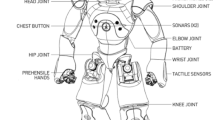Abstract
There is an increasing trend in using robots for medical purposes. One specific area is the rehabilitation. There are some commercial exercise machines used for rehabilitation purposes. However, these machines have limited use because of their insufficient motion freedom. In addition, these types of machines are not actively controlled and therefore can not accommodate complicated exercises required during rehabilitation. In this study, a rule based intelligent control methodology is proposed to imitate the faculties of an experienced physiotherapist. These involve interpretation of patient reactions, storing the information received, acting according to the available data, and learning from the previous experiences. Robot manipulator is driven by a servo motor and controlled by a computer using force/torque and position sensor information. Impedance control technique is selected for the force control.
Similar content being viewed by others
References
Aisen M.L., Krebs H.I., Hogan N. (1997) The effect of robot assisted therapy and rehabilitative training on motor recovery following stroke. Archives of Neurology 54: 443–446
Bernhardt, M., Frey, M., Colombo, G., & Riener, R. (2005). Hybrid force-position control yields cooperative behaviour of the rehabilitation robot LOKOMAT. In 9th International Conference on Rehabilitation Robotics, ICORR2005 (pp. 536–539).
CPM. (2007). www.arthroscopy.com/cpm.gif.
Culmer, P., Jackson, A., Levesley, M. C., et al. (2005). An admittance control scheme for a robotic upper-limb stroke rehabilitation system. In Proceedings of the 2005 IEEE Engineering in Medicine and Biology 27th Annual Conference, Shanghai, China.
Dutta A., Obinata G. (2002) Impedance control of a robotic gripper for cooperation with humans. Control Engineering Practice 10: 379–389
Hogan N. (1985) Impedance control: An approach to manipulation Part I, II, III. Journal of Dynamic Systems, Measurements and Control 107: 1–7
Homma, K., Fukuda, O., & Nagata, Y. (2002). Study of a wire-driven leg rehabilitation system. In Proceeding of Sixth Int. Conf. On Int. Robots and Systems (pp. 1451–1456).
Ju M.-S., Lin C.-C.K., Lin D.-H., Hwang I.-S., Chen S.-M. (2005) A rehabilitation robot with force-position hybrid fuzzy controller: Hybrid fuzzy control of rehabilitation robot. IEEE Transactions on Neural Systems and Rehabilitation Engineering 13(3): 349–358
Jung S., Hsia T.C. (1998) Neural network impedance force control of robot manipulator. IEEE Transactions on Industrial Electronics 45(3): 451–461
Khalili D., Zomlefer M. (1988) An intelligent system for rehabilitation of joints and estimation of body segment parameters. IEEE Transaction on Bio medical Engineering 35(2): 138–146
Krebs H.I., Hogan N., Aisen M.L., Volpe B.T. (1998) Robot aided neurorehabilitation. IEEE Transactions on Rehabilitation Engineering 6(1): 75–87
Krebs H.I., Palazzolo J.J., Volpe B.T., Hogan N. (2003) Rehabilitation robotics: Performance based progressive robot assisted therapy. Autonomous Robots 15: 7–20
Lee, S., Agah, A., & Bekey, G. (1990). An intelligent rehabilitative orthotic system for cerebrovascular accident. In IEEE International Conference on Systems, Man and Cybernetics Conference Proceedings (pp. 815–819).
Loueiro R., Amirabdollahian F., Topping M., Driessen B., Harwin W. (2003) Upper limb mediated stroke therapy—GENTLE/s approach. Autonomus Robots 15: 35–51
Lum P., Lehman S., Steven L., Reinkensmeyer, David J. (1995) The bimanual lifting rehabilitator: An adaptive machine for theraphy of stroke patient. IEEE Transactions on Rehabilitation Engineering 3(2): 166–173
Lum, S., Burgar, G., & Van Der Loos, M. (1997). The use of robotic device for post stroke movement therapy. In Proceedings of The International Conference on Rehabilitation Robotics (pp. 79–82).
MULOS Project. (1997). http://www.asel.udel.edu/robotics/newsetter/showcase12.html.
Nagata, F., Watanabe, K., Sato, K., & Izumi, K. (1998). Position-based impedance control using fuzzy enviroment models. In Proceedings of the 37th SICE Annual Conference. International Session Papers (pp. 837–842).
Okada S., Sakaki T. et al (2000) TEM: A therapeutic exercise machine for the lower extremities Of spastic patient. Advanced Robotics 14(7): 597–606
Rao, R., Agrawal, S. K., & Scholz, J. P. (1999). In Proceedings of International Conference on Rehabilitation Robotics (pp. 187–200).
REHAROB Project. (2000). http://reharob.manuf.bme.hu.
Reinkensmeyer D.J., Kahn L.E., Averbuch M., McKenna-Cole A.N., Schmit B.D., Rymer W.Z. (2000) Understanding and treating arm movement impairment after chronic brain injury: Progress with the ARM Guide. Journal of Rehabilitation Research and Development 37(6): 653–662
Richardson, R., Austin, M. E., & Plummer, A. R. (1999). Development of a physiotherapy robot. In Proceedings of the International Biomechatronics Workshop, Enshede (pp. 116–120).
Richardson R., Brown M., Bhakta M., Levesley M.C. (2003) Design and control of a three degree of freedom pneumatic physiotherapy robot. Robotica 21: 589–604
Richarson R., Levesley M.C., Brown M., Walker P. (2005) Impedance control for a pneumatic robot-based around pole-placement, joint space controllers. Control Engineering Practise 13: 291–303
Sakaki, T., Hirata, R., Okada, S., et al. (2001). TEM: Therapeutic exercises machine rehabilitation robot for stroke patient. In 32nd ISR.
Sakaki, T., Okada, S., Okajima, Y., Tanaka, N., Kimura, A., Uchida, S., et al. (1999). TEM: Therapeutic exercise machine for hip and knee joints of spastic patients. In Proceeding of Sixth International Conference on Rehabilitation Robotics (pp. 183–186).
Salter R., Simmonds B.W. (1980) The biological effect of continuous passive motion on the healing of full thickness defects in articular cartilage: An experimental investigation in the rabbit. The Journal of Bone and Joint Surgery 62-A: 1232–1251
Tanaka, Y., Tsuji, T., & Kaneko, M. (2000). A bio-mimetic rehabilitation aid for motor-control training using time base generator. In Industrial Electronics Society, IECON 2000. 26th Annual Conference of the IEEE, Nagoya, Japan (Vol. 1, pp. 114–119).
Tsuji T., Terauchi M., Tanaka Y. (2004) Online learning of virtual impedance parameters in non-contact impedance control using neural networks. IEEE Trans on Systems, Man and Cybernetics-Part B: CYBERNETICS 34(35): 2212–2118
Yoshikawa T. (1990) Foundations of robotics-analysis and control. The MIT Press, London
Author information
Authors and Affiliations
Corresponding author
Rights and permissions
About this article
Cite this article
Akdoğan, E., Taçgın, E. & Adli, M.A. Knee rehabilitation using an intelligent robotic system. J Intell Manuf 20, 195–202 (2009). https://doi.org/10.1007/s10845-008-0225-y
Received:
Accepted:
Published:
Issue Date:
DOI: https://doi.org/10.1007/s10845-008-0225-y




